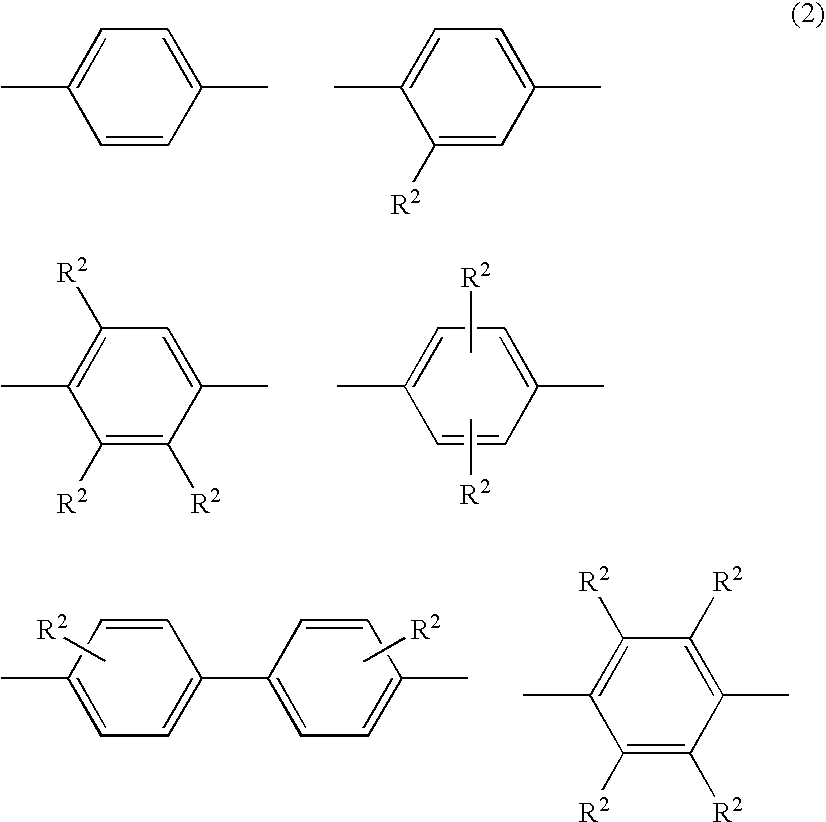Adhesive Film and Use Thereof
a technology of adhesive film and film adhesive, applied in the field of adhesive film, can solve the problems of affecting the dimensional stability of the resultant laminate film, affecting the heat resistance of the three-layer adhesive, and affecting the heat resistance of the film adhesive,
- Summary
- Abstract
- Description
- Claims
- Application Information
AI Technical Summary
Benefits of technology
Problems solved by technology
Method used
Image
Examples
synthesis example 1
OF POLYAMIDE ACID
Polyamide Acid as Precursor of Highly Heat Resistant Polyimide
[0139]Into 239 kg of N,N-dimethylformamid (hereinafter, referred to as “DMF” where appropriate) cooled to 10° C., 6.9 kg of 4,4-oxydianiline (hereinafter, referred to as “ODA”), 6.2 kg of p-phenylenediamine (hereinafter, referred to as “p-PDA” where appropriate), and 9.4 kg of 2,2-bis[4-(4-aminophenoxy)phenyl]propane (hereinafter, referred to as “BAPP”) were dissolved. Then, 10.4 g of pyromellitic dianhydride (hereinafter, referred to as “PMDA” where appropriate) was added in the thus prepared solution, and dissolved under stirring for 1 hour. Further, 20.3 kg of benzophenonetetracarboxylic dianhydride (hereinafter, referred to as “BTDA”) was added and dissolved under stirring for 1 hour. In this way, a reaction solution was prepared.
[0140]The DMF solution of PMDA (PMAD:DMF=0.9 kg: 7.0 kg), which solution was prepared separately, was gradually added into the reaction solution until a viscosity of 1×102 Pa...
synthesis example 2
OF POLYAMIDE ACID
Polyamide Acid as Precursor of Highly Heat Resistant Polyimide
[0141]Into 239 kg of DMF cooled to 10° C., 12.6 kg of ODA, 6.8 kg of p-PDA, and 15.6 kg of PMDA were added and dissolved under stirring for 1 hour. Into the thus obtained solution, 12.2 kg of BTDA was added and dissolved under stirring for another 1 hour. Into the thus obtained solution, 5.8 kg of p-phenylenebis (trimellitic monoester acid anhydride) (hereinafter, referred to as “TMHQ”) was added and dissolved under stirring for 2 hours. In this way, a reaction solution was prepared.
[0142]The DMF solution of PMDA (PMAD:DMF=0.9 kg: 7.0 kg), which solution was prepared separately, was gradually added into the reaction solution until a viscosity of 1×102 Pa·sec. After that, the reaction solution was stirred for 1 hour to attain an organic solvent solution of an polyamide acid (a2) (hereinafter, referred to as “polyamide acid solution (a2)” for the sake of easy explanation), which had a solid content of 18 wt...
synthesis example 3
OF POLYAMIDE ACID
Polyamide Acid as Precursor of Thermoplastic Polyimide
[0143]Into a reaction vessel of 300 L in volume, 78 kg of DMF, and 11.72 kg of bis[4-(4-aminophenoxy)phenyl]sulfone (hereinafter, referred to as “BAPS” where appropriate) were added. Then, 7.17 kg of 3,3′,4,4′-biphenyltetracarboxylic dianhydride (hereinafter, referred to as “BPDA”) was gradually added in the thus obtained solution with stirring under nitrogen atmosphere. Subsequently, 0.56 kg of 3,3′,4,4′-ethyleneglycoldibenzoatetetracarboxylic dianhydride (hereinafter, referred to as “TMEG”) was added in the solution. Then, the solution was stirred for 30 minutes in an ice bath. Into the thus prepared reaction solution, a separately-prepared solution of 0.55 kg of TMEG dissolved in 2 kg of DMF was gradually added under stirring, while monitoring a viscosity of the reaction solution. The addition was ceased when the viscosity reached 1×102 Pa·sec. After 146.3 kg of DMF was further added therein, the solution was ...
PUM
| Property | Measurement | Unit |
|---|---|---|
| thermal shrinkage ratio | aaaaa | aaaaa |
| thermal shrinkage ratio | aaaaa | aaaaa |
| tensile elastic moduli | aaaaa | aaaaa |
Abstract
Description
Claims
Application Information
 Login to View More
Login to View More - R&D
- Intellectual Property
- Life Sciences
- Materials
- Tech Scout
- Unparalleled Data Quality
- Higher Quality Content
- 60% Fewer Hallucinations
Browse by: Latest US Patents, China's latest patents, Technical Efficacy Thesaurus, Application Domain, Technology Topic, Popular Technical Reports.
© 2025 PatSnap. All rights reserved.Legal|Privacy policy|Modern Slavery Act Transparency Statement|Sitemap|About US| Contact US: help@patsnap.com



